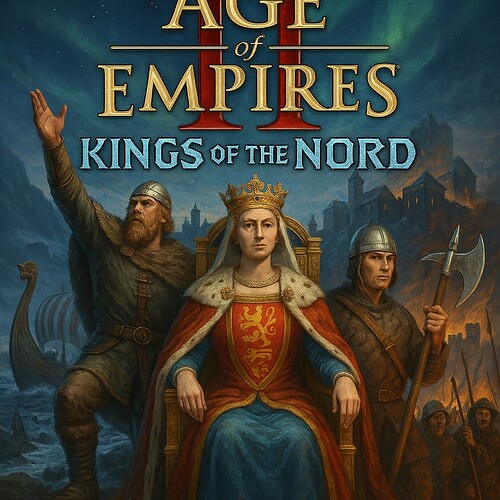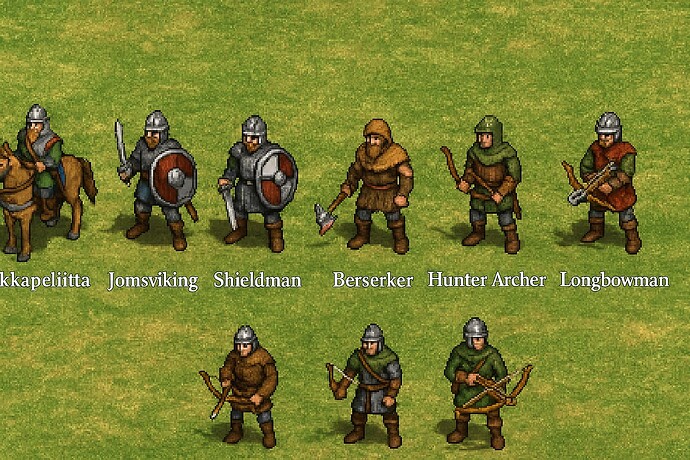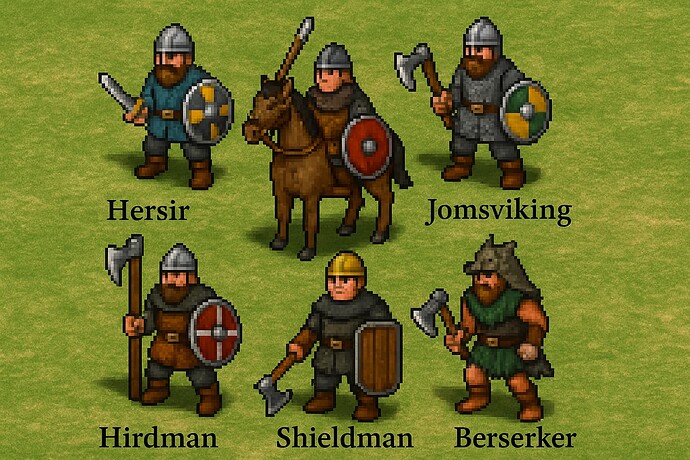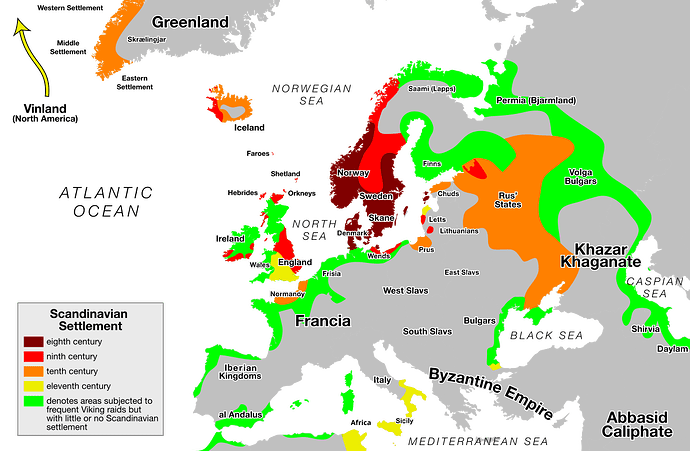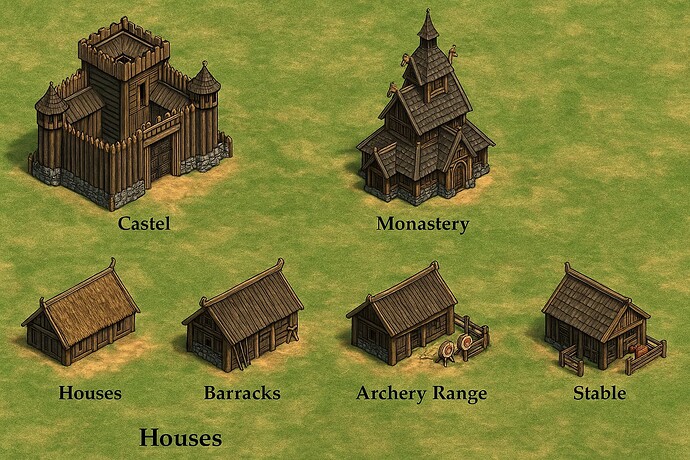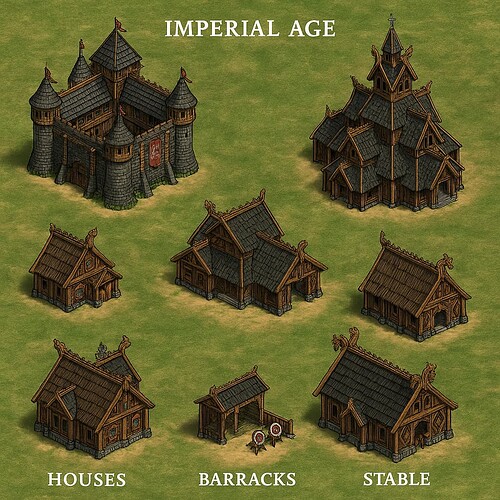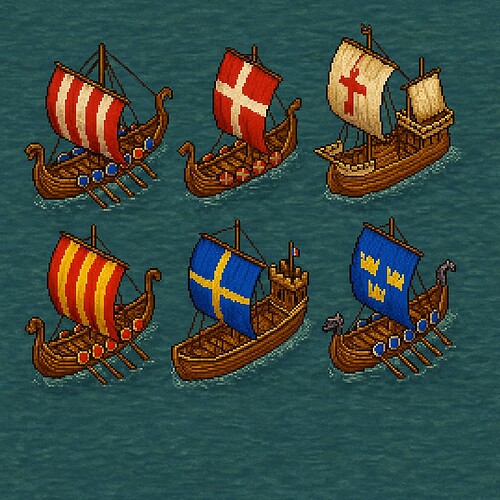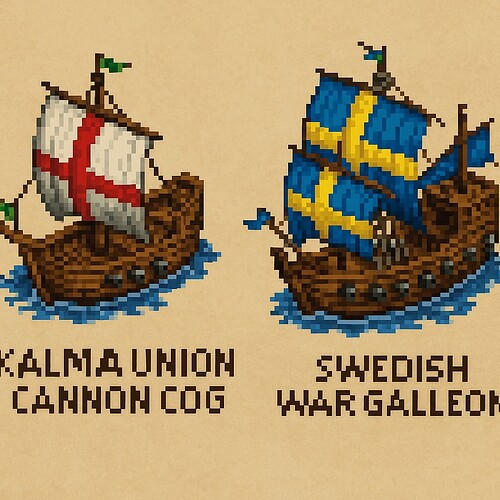Hi everyone!
I’ve prepared a new, complete concept for the next DLC expansion — this time set in medieval Scandinavia. The spotlight is on Norwegians ![]() , Swedes
, Swedes ![]() , and Danes
, and Danes ![]() , whose history eventually converges in the Kalmar Union.
, whose history eventually converges in the Kalmar Union.
This DLC introduces not only new civilizations and units, but also campaigns based on real historical figures and events that shaped Northern Europe.
 Timeline & Historical Context
Timeline & Historical Context
- 9th–11th c. – Norwegian expansion across the Atlantic (Iceland, Greenland, England, Vinland).
- 13th–14th c. – economic growth of Gotland and Swedish mining centers.
- 14th–15th c. – the unification of Scandinavia under Queen Margaret I and the rise of the Kalmar Union.
The campaigns span three distinct periods, but all remain within the spirit of the Middle Ages — exactly what the AoE2 community craves.
 New Civilizations: The Northmen
New Civilizations: The Northmen
 Norwegians (NORSE)
Norwegians (NORSE)
- Theme: far-seafaring explorers and warriors of the fjords.
- Bonuses:
- Transport Ships are faster and cheaper
- Infantry gains bonuses in forests and on hills
- Warships +10% HP
- Unique Unit:
- Hirdman – heavy infantry with shield, strong vs. cavalry.
- Unique Technology:
- Saga of Leif – Transport Ships gain higher capacity and stronger armor.
 Swedes
Swedes
- Theme: mining and trade power, strong infantry and artillery.
- Bonuses:
- Gold and stone mines last longer
- Crossbowmen fire faster
- Bombard Cannons and Cannon Galleons gain extra range
- Unique Unit:
- Hakkapeliitta – fast light cavalry with a ranged strike (hit-and-run).
- Unique Technology:
- Gotland Steel – grants +armor to infantry and ships.
 Danes (Kalmar Union)
Danes (Kalmar Union)
- Theme: control of the Øresund and maritime trade dominance.
- Bonuses:
- Trade Cogs generate extra gold
- Coastal Castles can build “Naval Workshops”
- Infantry is cheaper when Monks garrison relics
- Unique Unit:
- Jomswiking – elite mercenary warrior, expensive but devastating in melee.
- Unique Technology:
- Sound Toll – doubles income from trade routes.
 Shared Northmen Features
Shared Northmen Features
- “Ports and Shipyards” – access to a Naval Workshop with unique upgrades.
- “Strength of the Sea” – all Northmen ships gain bonus HP.
- “Legacy of the Union” – in team games, Northmen civs grant each other extra naval bonuses.
 New Campaigns & Heroes
New Campaigns & Heroes
1.  Olaf Tryggvason – Campaign Outline
Olaf Tryggvason – Campaign Outline
Background
Olaf Tryggvason (c. 960–1000) was one of the most charismatic Viking rulers. Born into a royal Norwegian bloodline, he spent his youth in exile, raiding across the Baltic, England, and Ireland. Later, he returned to Norway with a powerful fleet, seized power, and began uniting the realm. His reign is remembered not only for war but also for his zealous attempt to Christianize Norway and Greenland — and for sending Leif Erikson westward to Vinland.
Scenario 1: Viking in Exile
- Map: The Baltic Sea, Slavic coast.
- Objectives: Survive with limited forces, raid coastal villages, and amass wealth to build a fleet.
- Special Twist: Olaf begins with no town center. He must rely on raids, mercenaries, and diplomacy.
Scenario 2: King of Norway
- Map: Norway’s rugged fjords.
- Objectives: Defeat rival jarls and unite the country under Olaf’s banner.
- Special Mechanics: Heavy use of longships for coastal assaults and quick raids. Open battles are dangerous — guerrilla tactics are favored.
Scenario 3: The Crusade of Conversion
- Map: Coastal Norway and Iceland.
- Objectives: Destroy pagan temples (Monasteries) and spread Christianity by training and protecting monks.
- Special Mechanics: Balance between economic growth and religious influence. Force can be used, but excessive violence may lead to rebellion events.
Scenario 4: The Road to Vinland
- Map: Three phases — Norway → Greenland → Vinland (North America).
- Objectives: Establish colonies and escort Leif Erikson safely to the New World.
- Special Mechanics: Build settlements along the way, fend off hostile weather events, and face Skrælings (native AI). Exploration and survival take priority over conquest.
Scenario 5: The Battle of Svolder (1000 AD)
- Map: Baltic islands, narrow straits.
- Objectives: Survive against the coalition of Danes, Swedes, and Jarl Eirik of Lade.
- Special Mechanics: Naval showdown. Olaf commands the legendary flagship Ormen Lange (the Long Serpent) with increased HP and attack.
- Ending: No matter the player’s efforts, Olaf’s fate is sealed — he leaps into the sea, vanishing from history. The epilogue shows Leif Erikson continuing his mission westward.
Olaf as a Hero Unit
- Type: Infantry (custom Huskarl-style).
- Abilities:
- Aura “Christianization”: boosts conversion speed of nearby monks.
- Command of the Long Serpent: unique longship with superior stats.
- Symbolism: A bridge between the pagan Viking world and the Christian medieval realm.
2.  Campaign: Queen Margaret I – Lady of the North
Campaign: Queen Margaret I – Lady of the North
Mission 1: Waldemar’s Legacy (1375)
- Background: After the death of King Valdemar Atterdag, Denmark is left without a clear successor. Margaret fights to secure the throne for her son Olaf. German princes and the Hanseatic League support rival claimants from Mecklenburg.
- Objectives:
- Maintain control over Denmark’s key castles.
- Repel attacks from Mecklenburg forces and the Hanseatic fleet.
- Crown Olaf as King of Denmark (build a Castle in Copenhagen).
- Mission style: Defensive + naval/economic warfare (constant raids from the Hanseatic League).
Mission 2: The Crown of Norway (1380)
- Background: After the death of Haakon VI, Olaf (Margaret’s son) inherits the Norwegian throne. However, local nobles and clans resist Danish influence.
- Objectives:
- Capture three Norwegian strongholds (Bergen, Nidaros, Oslo).
- Secure the seas against pirates.
- Survive until Olaf’s coronation.
- Mission style: Land and naval conquest on a rugged, fjord-filled map.
Mission 3: A Shadow over Sweden (1388–1389)
- Background: Discontent with their king, Swedish nobles invite Margaret to claim the throne. King Albert of Mecklenburg raises an army to resist her.
- Objectives:
- Gain the support of Swedish nobles (ally with towns).
- Defeat King Albert in the Battle of Åsle.
- Imprison Albert in Kalmar Castle (escort him to the fortress).
- Mission style: Large field battle + political elements (towns can switch allegiance if persuaded).
Mission 4: The Kalmar Union (1397)
- Background: After her victory over Albert, Margaret convenes the nobles of Denmark, Norway, and Sweden at Kalmar to unite them under one monarchy. Not everyone accepts her rule—rebels rise to oppose unification.
- Objectives:
- Capture and hold the three capitals: Copenhagen, Oslo, Stockholm.
- Defeat the rebel forces.
- Secure the throne for Eric of Pomerania.
- Mission style: Epic, multi-phase scenario—initial diplomacy (convincing towns), followed by full-scale war against rebels.
Mission 5: Lady of the North (1397–1412)
- Background: Though the Kalmar Union is established, maintaining it is far from easy. The Hanseatic League continues its hostility, and unrest brews within the union. Margaret must summon all her strength to preserve stability.
- Objectives:
- Defeat the Hanseatic fleet and secure Baltic trade routes.
- Suppress internal rebellions in Sweden.
- Construct the “Palace of the North” (Wonder) to symbolize dominance over the union.
- Mission style: Economy + naval battles + suppressing uprisings across the map. A final showcase of Margaret’s power.
 Campaign Themes
Campaign Themes
- Unification of Scandinavia – narrative of political brilliance and resilience.
- Wars with the Hanseatic League – strong emphasis on naval gameplay.
- Rebellious Sweden – balance between alliances and conquest.
- A female ruler in the Middle Ages – rare and powerful theme, like Joan of Arc.
3.  Campaign: Engelbrekt Engelbrektsson – The Swedish Rebellion
Campaign: Engelbrekt Engelbrektsson – The Swedish Rebellion
Mission 1: The Spark of Revolt (1434)
- Background: Peasants and miners of Bergslagen rise against the crushing taxes and abuses of King Eric of Pomerania’s officials. Engelbrekt emerges as their leader.
- Objectives:
- Establish your base in the mountains (survive the first royal attacks).
- Recruit peasants and miners (convert villages / train unique rebel units).
- Destroy the bailiff’s stronghold in Västerås.
- Mission style: Asymmetric start – weak forces, improvised peasant army.
Mission 2: March on the Castles (1434–1435)
- Background: The rebellion spreads across Sweden. Engelbrekt captures several royal strongholds, gaining support from the common people.
- Objectives:
- Capture three royal castles (Falun, Örebro, Borgholm).
- Protect the villages (lose no more than 2).
- Mission style: Castle conquest with limited resources – rely on local recruitment.
Mission 3: The Riksdag of Arboga (1435)
- Background: Engelbrekt is formally elected “Captain of the Realm,” while nobles and clergy must accept his leadership. Yet some elites distrust a leader of the common folk.
- Objectives:
- Secure the allegiance of nobles and clergy (alliance/diplomacy).
- Repel royal counterattacks.
- Keep Engelbrekt alive throughout the mission.
- Mission style: Political + defensive – diplomacy and survival are key.
Mission 4: The Shadow of Betrayal (1436)
- Background: Engelbrekt’s power is limited by rival noble Karl Knutsson Bonde, and internal conflicts weaken the movement. Royal armies attempt to regain control.
- Objectives:
- Defeat the royal army in a pitched battle.
- Prevent treacherous vassals from seizing Stockholm.
- Mission style: Large open battle + twist where allies can betray you mid-scenario.
Mission 5: The Fall of a Hero (1436)
- Background: Engelbrekt is assassinated by the knight Magnus Bengtsson. The rebellion loses its leader, yet his legacy lives on as a symbol of Swedish resistance.
- Objectives:
- Defend the last rebel strongholds for a set time.
- Protect at least 5 villages to keep the people’s morale.
- After Engelbrekt’s death, survive until a new leader emerges (Karl Knutsson Bonde as an ally).
- Mission style: Defensive with dramatic mid-scenario event (death of the hero). Tragic yet heroic conclusion, similar to Joan of Arc’s campaign.
 Campaign Themes
Campaign Themes
- Popular rebellion – peasants and miners against royal power.
- Uneven struggle – weak forces vs. castles and professional armies.
- Political tensions – initial unity, later betrayal and division.
- Heroic legacy – Engelbrekt dies, but becomes a symbol of Swedish freedom.
 New Special Units (for campaigns / scenarios)
New Special Units (for campaigns / scenarios)
- Longship – faster Drakkar with both transport and ranged attack.
- Fjord Guardian – heavy naval infantry (pike + shield).
- Harvester-Sailor – eco unit: fishes faster and can repair ships.
 Nordic Architecture – New Set
Nordic Architecture – New Set
The DLC would introduce a new “Nordic” architectural style, distinct from other European sets.
- Houses
 – long wooden halls with turf or shingle roofs, dragon-head carvings.
– long wooden halls with turf or shingle roofs, dragon-head carvings. - Town Center
 – rectangular wooden hall with central hearth and carved beams.
– rectangular wooden hall with central hearth and carved beams. - Monasteries & Churches
 – inspired by stave churches: tall, multi-tiered, richly decorated.
– inspired by stave churches: tall, multi-tiered, richly decorated. - Walls & Towers
 – timber-stone mix, simpler but sturdy.
– timber-stone mix, simpler but sturdy. - Castles
 – cliffside or fjord fortresses, wood-stone hybrids built on hills above water.
– cliffside or fjord fortresses, wood-stone hybrids built on hills above water. - Docks & Shipyards
 – long boathouses with visible Drakkar hulls, adorned with dragon motifs.
– long boathouses with visible Drakkar hulls, adorned with dragon motifs.
![]() Visual identity: dark wood, steep gables, dragon carvings, stave churches — instantly recognizable on the map.
Visual identity: dark wood, steep gables, dragon carvings, stave churches — instantly recognizable on the map.
 Community Feedback – Answers
Community Feedback – Answers
“Won’t the Northmen be OP on water maps?”
![]() Each civ has its own naval niche: Norwegians = mobility, Swedes = artillery, Danes = trade. None dominates in all aspects.
Each civ has its own naval niche: Norwegians = mobility, Swedes = artillery, Danes = trade. None dominates in all aspects.
“Should the Kalmar Union be its own civ?”
![]() Better as a team bonus mechanic, representing the alliance rather than a fusion civilization.
Better as a team bonus mechanic, representing the alliance rather than a fusion civilization.
“Will heroes get active skills?”
![]() Only simple auras (healing, morale, one-time conversion), consistent with the AoE2 engine. No MOBA-style abilities.
Only simple auras (healing, morale, one-time conversion), consistent with the AoE2 engine. No MOBA-style abilities.
 Why “Kings of the North”?
Why “Kings of the North”?
- A return to the Middle Ages, exactly what the community is asking for.
- Three civs with a shared theme but unique gameplay.
- Campaigns rooted in real historical events and legendary figures.
- Expands AoE2 into Northern Europe — a region long underrepresented in the game.
 Questions for You
Questions for You
- Which campaign sounds the most exciting?
- How would you balance Northmen naval power?
- Which other Nordic heroes would you like to see?
Castel Age:
Imperial Age:
Castel Age
Extra Imperial Age
